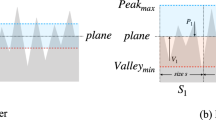Abstract
This work deals with the determination of the parameters that have influence in the scanning of parts with different surface roughness. A commercial laser stripe system has been used for capturing points on a part surface by means of triangulation techniques. The parameters which can be affected by the roughness surface are first analyzed in order to establish the optimal conditions for the scanning tests. This way, gauges with different roughness grades and manufactured by different processing technologies have been tested. Since the roughness gauges were flat, the set of points captured onto a plane as well as their spatial dispersion with regard to the best-fit plane have been used as indicators of quality of the scanning process. The results of the tests provide some recommendations about the methodology and working conditions for scanning each type of surface.
Similar content being viewed by others
References
Chen F, Brown GM, Song M (2000) Overview of three-dimensional shape measurement using optical methods. Opt Eng 39(1):10–22 doi:10.1117/1.602438
Blais F (2003) A review of 20 years of range sensor development. In: Proceedings of SPIE-IS&T Electronic Imaging, SPIE, Santa Clara, California, USA, 5013, pp 62–76
Fan K-C (1997) A non-contact automatic measurement for free-form surface profile. Comput Integrated Manuf Syst 10(4):277–285 doi:10.1016/S0951-5240(97)00020-7
Curless B, Levoy M (1995) Better optical triangulation through space time analysis. In: Proceedings of the 5th International Conference on Computer Vision, Boston, MA, USA, pp 20–23
Dorsch RG, Häusler G, Herrmann JM (1994) Laser triangulation: fundamental uncertainty in distance measurement. Appl Opt 33(7):1306–1314
Forest J, Salvi J (2004) Laser stripe peak detector for 3D scanners. A FIR filter approach. In: Proceedings of the Pattern Recognition, 17th International Conference on Pattern Recognition (ICPR’04), Cambridge, UK, 3, pp 646–649.
Hüser D, Rothe H (1998) Robust averaging of signals for triangulation sensors. Meas Sci Technol 9(7):1017–1023 doi:10.1088/0957-0233/9/7/002
Wang SH, Tay CJ, Quan C, Shang HM, Zhou ZF (2000) Laser integrated measurement of surface roughness and micro-displacement. Meas Sci Technol 11(5):454–458 doi:10.1088/0957-0233/11/5/302
Feng H-Y, Liu Y, Xi F (2001) Analysis of digitizing errors of a laser scanning system. Precis Eng 25(3):185–191 doi:10.1016/S0141-6359(00)00071-4
Godin G, Beraldin J-A, Rioux M, Levoy M, Cournoyer L (2001) An assessment of laser range measurement on marble surfaces. In: Proceedings of the 5th Conference on Optical 3D Measurement Techniques, Vienna, Austria, pp 49–56
Kim K-C, Kim JA, Kim S, Kwak YK (2000) A robust signal processing algorithm for linear displacement measuring optical transmission sensors. Rev Sci Instrum 71(8):3220–3225 doi:10.1063/1.1304870
Lee S-J, Chang D-Y (2006) A laser sensor with multiple detectors for freeform surface digitization. Int J Adv Manuf Technol 31(5–6):474–482 doi:10.1007/s00170-005-0212-9
Harris JO, Spence AD (2004) Geometric and quasi-static thermal error compensation for a laser digitizer equipped coordinate measuring machine. Int J Mach Tools Manuf 44(1):65–77 doi:10.1016/j.ijmachtools.2003.08.002
Author information
Authors and Affiliations
Corresponding author
Rights and permissions
About this article
Cite this article
Cuesta, E., Rico, J.C., Fernández, P. et al. Influence of roughness on surface scanning by means of a laser stripe system. Int J Adv Manuf Technol 43, 1157–1166 (2009). https://doi.org/10.1007/s00170-008-1794-9
Received:
Accepted:
Published:
Issue Date:
DOI: https://doi.org/10.1007/s00170-008-1794-9




